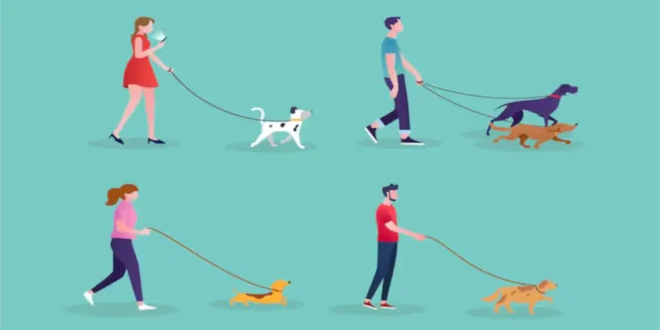Table of Contents
ToggleThe Complete Guide to Choosing the Best No Pull Dog Harness
Dogs are naturally active animals, and taking them for regular walks is essential for their physical and mental well-being. However, if you’ve ever found yourself struggling to control a dog that pulls, you know how challenging and exhausting it can be. That’s where a no pull dog harness becomes invaluable. Designed to prevent dogs from pulling on the leash, a no pull harness can turn a chaotic walk into a peaceful, enjoyable experience for both you and your pup.
In this guide, we’ll explore everything you need to know about no pull dog harnesses – what they are, how they work, the benefits they offer, and the factors to consider when choosing the right harness for your dog.
What is a No Pull Dog Harness?
A no pull dog harness is a specially designed harness that discourages dogs from pulling on the leash. Unlike traditional collars or harnesses, which can encourage pulling or be uncomfortable for dogs, no pull harnesses distribute pressure more evenly across the dog’s body, preventing injury and reducing the dog’s desire to pull.
Typically, a no pull harness has a leash attachment point on the chest rather than the back. This front clip design helps redirect the dog’s movement toward you when they try to pull forward, which reduces their momentum and encourages them to walk at your pace.
How Does a No Pull Dog Harness Work?
A no pull harness works by using a simple yet effective mechanism. When a dog attempts to pull, the front attachment redirects the forward motion, making it difficult for them to gain traction and continue pulling. This gentle correction guides the dog back toward you, reinforcing the idea that pulling won’t get them closer to where they want to go.
Unlike choke chains or prong collars, a no pull harness is a humane option that doesn’t cause pain or discomfort. Instead, it relies on redirection and the natural limitations of the harness design to discourage pulling. This makes it an excellent choice for training dogs to walk on a loose leash without causing harm or distress.
Benefits of Using a No Pull Dog Harness
Choosing a no pull dog harness has several benefits for both you and your dog. Here are some of the most significant advantages:
1. Improved Control
A no pull harness offers you greater control over your dog’s movements, making it easier to handle even large or energetic dogs. By attaching the leash to the front, you can redirect your dog’s path, making it easier to manage their behavior and keep them walking by your side.
2. Injury Prevention
Traditional collars and harnesses can strain a dog’s neck, especially if they’re prone to pulling. A no pull harness distributes pressure more evenly across the dog’s chest and shoulders, reducing the risk of neck and throat injuries.
3. Enhanced Training
No pull harnesses are ideal for training dogs to walk on a leash. By discouraging pulling, the harness helps no pull dog harness
reinforce positive leash-walking habits, making it easier to teach your dog to walk calmly without lunging or pulling.
4. Comfort for Your Dog
Many no pull harnesses are designed with padded, comfortable materials that reduce chafing and pressure points. This makes walks more enjoyable for your dog, encouraging them to stay calm and relaxed while walking.
5. Reduced Stress for Owners
Walking a dog that constantly pulls can be exhausting and stressful. A no pull harness makes walks more no pull dog harness
enjoyable by giving you more control, allowing you to focus on enjoying your time with your dog rather than battling to keep them in check.
Types of No Pull Dog Harnesses
When it comes to no pull harnesses, there are several designs to choose from. Each type has its own unique no pull dog harness
features, and the right choice depends on your dog’s size, temperament, and specific walking needs. Here are some of the most common types:
1. Front Clip Harness
The front clip harness is the most common type of no pull harness. It features a leash attachment on the chest, which helps redirect the dog’s motion when they try to pull. This type of harness is effective for most dogs and is suitable for both training and regular walks.
2. Dual Clip Harness
A dual clip harness has both front and back leash attachment points, offering versatility. The front clip can be no pull dog harness
used for no pull training, while the back clip is suitable for dogs that have learned to walk calmly. This type is ideal for pet owners who want the flexibility to switch between no pull and standard walking modes.
3. Vest Harness
Vest harnesses are typically made from soft, padded materials and cover a larger area of the dog’s chest and no pull dog harness
back. While they may not have a front clip attachment, some vest harnesses are designed to discourage pulling by offering a snug, comfortable fit that reduces the dog’s desire to pull.
4. Head Halter Harness
A head halter is a type of no pull harness that fits over the dog’s nose and attaches to the leash at the back of the head. When the dog tries to pull, the halter gently redirects their head, making it difficult to continue forward. While effective, head halters require some acclimation, as dogs may initially find the sensation unusual.
Choosing the Right No Pull Harness for Your Dog
Selecting the right no pull harness for your dog involves considering several factors. Each dog is unique, and no pull dog harness
what works for one dog may not be suitable for another. Here’s what to keep in mind when choosing a no pull harness:
1. Size and Fit
Ensuring the right fit is crucial. A harness that is too tight can cause discomfort and restrict movement, while a harness that is too loose may not be effective at controlling pulling. Measure your dog’s chest and neck before purchasing a harness, and refer to the manufacturer’s sizing chart to find the best fit.
2. Material and Comfort
Choose a harness made from durable, comfortable materials that won’t chafe or irritate your dog’s skin. Look for options with padding and breathable fabrics, especially if you plan on using the harness for extended periods.
3. Ease of Use
Some harnesses can be complicated to put on and take off, which can be frustrating for both you and your dog. Look for a harness with simple buckles or clips that allow for easy adjustment and donning.
4. Training Needs
If you’re in the process of training your dog to walk on a leash, a front clip or dual clip harness may be the best option. These designs offer the control needed for training while allowing you to switch to a standard leash no pull dog harness
attachment once your dog is trained.
5. Durability
Dogs can be rough on their gear, so choose a harness that is built to withstand wear and tear. Look for strong stitching, reinforced buckles, and materials that can handle your dog’s energy level and size.
Top No Pull Dog Harness Recommendations
To help you find the best harness for your dog, here are some highly recommended no pull harnesses that offer a balance of comfort, durability, and functionality:
1. PetSafe Easy Walk Harness
The PetSafe Easy Walk harness is one of the most popular no pull options on the market. With a front chest leash attachment, it effectively discourages pulling without causing discomfort. The harness is available in a range of sizes and features adjustable straps for a custom fit.
2. Ruffwear Front Range Harness
The Ruffwear Front Range harness is a high-quality option with both front and back leash attachments. It’s made from durable materials and includes padded straps for added comfort. Ideal for active dogs, this harness is designed to withstand rough use.
3. Rabbitgoo No Pull Dog Harness
The Rabbitgoo harness is known for its affordability and effectiveness. It features a front clip to prevent pulling and a back clip for regular walks. The harness is padded and adjustable, providing comfort and control for dogs of all sizes.
4. Kurgo Tru-Fit Smart Harness
The Kurgo Tru-Fit harness is a versatile, dual-clip harness that works well for both no pull training and regular walking. With padded chest straps and sturdy construction, it’s comfortable for extended use and suitable for travel.
5. Blue-9 Balance Harness
The Blue-9 Balance harness offers excellent control and adjustability. It features multiple adjustment points, no pull dog harness
allowing for a custom fit, and is designed to reduce pulling by guiding your dog back toward you.
Training Tips for Using a No Pull Harness
Using a no pull harness effectively requires some basic training techniques. Here are a few tips to help you make the most of your harness:
- Use Positive Reinforcement: Reward your dog with treats or praise when they walk calmly beside you. This helps reinforce good behavior and encourages them to stay by your side.
- Practice Redirection: If your dog starts to pull, stop walking and wait for them to return to your side. Use the harness’s front clip to gently guide them back toward you, then resume walking.
- Stay Consistent: Consistency is key to successful leash training. Use the no pull harness every time you walk your dog, and avoid using a regular collar or harness that may encourage pulling.
Conclusion
A no pull dog harness is an invaluable tool for any dog owner who wants to enjoy peaceful, enjoyable walks no pull dog harness
without the stress of constant pulling. By choosing the right harness and incorporating basic training techniques, you can teach your dog to walk calmly and comfortably by your side. Whether you’re training a puppy or managing an energetic adult dog, a no pull harness offers a safe, humane, and effective solution to leash pulling, making walks a pleasure for both you and your furry friend.
Frequently Asked Questions (FAQs)
What is the purpose of a no pull harness for dogs?
A no pull harness is designed to discourage dogs from pulling on the leash by redirecting their movement. This type of harness provides better control over your dog’s walking behavior, making walks more manageable and enjoyable.
Are no pull harnesses safe and comfortable for dogs?
Yes, no pull harnesses are generally safe and designed with comfort in mind. They distribute pressure evenly no pull dog harness
across the dog’s chest, reducing strain on the neck and throat. Many harnesses include padded areas to prevent chafing and ensure a comfortable fit.
Can a no pull harness help train my dog to stop pulling?
Absolutely. A no pull harness is an effective training tool for teaching dogs to walk on a loose leash. The design encourages good walking habits without causing discomfort, making it easier for your dog to learn to stay by your side.
How do I choose the right no pull harness for my dog?
To choose the right no pull harness, consider your dog’s size, temperament, and specific walking needs. Look for a harness that offers a comfortable fit, durable materials, and a suitable leash attachment based on your dog’s pulling tendencies and training requirements.
What is the difference between a front clip and a dual clip harness?
A front clip harness has a single attachment point at the chest, ideal for controlling pulling behavior. A dual clip harness has both a front and back attachment, giving you flexibility for training purposes or for dogs that have already mastered loose-leash walking.
Are no pull harnesses suitable for all dog breeds?
Yes, no pull harnesses are suitable for all breeds. They come in various sizes and styles, making it easy to find one that fits your dog comfortably. Whether you have a small, medium, or large breed, there’s a no pull harness designed to meet your needs.
READ ALSO: The Ultimate Guide to Maternity Leggings: Comfort, Style, and Functionality
 Touch Blog
Touch Blog



